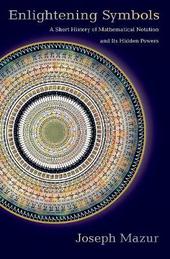
|
Enlightening Symbols: A Short History of Mathematical Notation and Its Hidden Powers
Paperback / softback
Main Details
| Title |
Enlightening Symbols: A Short History of Mathematical Notation and Its Hidden Powers
|
| Authors and Contributors |
By (author) Joseph Mazur
|
| Physical Properties |
| Format:Paperback / softback | | Pages:312 | | Dimensions(mm): Height 235,Width 152 |
|
| ISBN/Barcode |
9780691173375
|
| Classifications | Dewey:510.9 |
|---|
| Audience | | Tertiary Education (US: College) | | Professional & Vocational | |
|---|
| Illustrations |
8 halftones. 38 line illus. 4 tables.
|
|
Publishing Details |
| Publisher |
Princeton University Press
|
| Imprint |
Princeton University Press
|
| Publication Date |
6 December 2016 |
| Publication Country |
United States
|
Description
While all of us regularly use basic math symbols such as those for plus, minus, and equals, few of us know that many of these symbols weren't available before the sixteenth century. What did mathematicians rely on for their work before then? And how did mathematical notations evolve into what we know today? In Enlightening Symbols, popular math wri
Author Biography
Joseph Mazur is the author of Euclid in the Rainforest (Plume), which was a finalist for the PEN/Martha Albrand Award, Zeno's Paradox (Plume), What's Luck Got to Do with It? (Princeton), and Fluke (Basic).
Reviews"Mazur (Euclid in the Rainforest) gives readers the fascinating history behind the mathematical symbols we use, and completely take for granted, every day. Mathematical notation turns numbers into sentences--or, to the uninitiated, a mysterious and impenetrable code. Mazur says the story of math symbols begins some 3,700 years ago, in ancient Babylon, where merchants incised tallies of goods on cuneiform tablets, along with the first place holder--a blank space. Many early cultures used letters for both numbers and an alphabet, but convenient objects like rods, fingers, and abacus beads, also proved popular. Mazur shows how our 'modern' system began in India, picking up the numeral 'zero' on its way to Europe, where it came into common use in the 16th century, thanks to travelers and merchants as well as mathematicians like Fibonacci. Signs for addition, subtraction, roots, and equivalence followed, but only became standardized through the influence of scientists and mathematicians like Rene Descartes and Gottfried Leibniz. Mazur's lively and accessible writing makes what could otherwise be a dry, arcane history as entertaining as it is informative."--Publishers Weekly "[A] fascinating narrative... This is a nuanced, intelligently framed chronicle packed with nuggets--such as the fact that Hindus, not Arabs, introduced Arabic numerals. In a word: enlightening."--George Szpiro, Nature "Mazur begins by illustrating how the ancient Incas and Mayans managed to write specific, huge numbers. Then, for more than 200 pages, he traces the history of division signs, square roots, pi, exponents, graph axes and other symbols in the context of cognition, communication, and analysis."--Washington Post "Mazur delivers a solid exposition of an element of mathematics that is fundamental to its history."--Library Journal "Mazur treats only a subset of F. Cajori's monumental A History of Mathematical Notation (Dover, 1993 first edition 1922) and there is overlap with many other mathematical history books, but Mazur adds new findings and insights and it is so much more entertaining ... and these features make it an interesting addition to the existing literature for anybody with only a slight interest in mathematics or its history."--European Mathematical Society "Symbols like '+' and '=' are so ingrained that it's hard to conceive of math without them. But a new book, Enlightening Symbols: A Short History of Mathematical Notation and its Hidden Power, offers a surprising reminder: Until the early 16th century, math contained no symbols at all."--Kevin Hartnett, Boston Globe "Enlightening Symbols retraces the winding road that has led to the way we now teach, study, and conceive mathematics... Thanks to Mazur's playful approach to the subject, Enlightening Symbols offers an enjoyable read."--Gaia Donati, Science "If you enjoy reading about history, languages and science, then you'll enjoy this book... The best part is the writing is compelling enough that you don't have to be a mathematician to enjoy this informative book."--Guardian.com's GrrlScientist blog "[I]nformative, highly readable and scholarly."--Brian Rotman, Literary Review "[T]his insightful account of the historical development of a highly characteristic feature of the mathematical enterprise also represents a valuable contribution to our understanding of the nature of mathematics."--Eduard Glas, Mathematical Reviews Clippings "Joseph Mazur's beautiful book Enlightening Symbols tells the story of human civilization through the development of mathematical notation. Surprises abound... The book is visually exquisite, great care having been taken with illustrations and figures. Mazur's discussion of the emergence of particular symbols affords the reader an overview of the often difficult primary literature."--Donal O'Shea, Sarasota Herald-Tribune "At whatever depth one chooses to read it, Enlightening Symbols has something for everyone. It is entertaining and eclectic, and Mazur's personal and easy style helps connect us with those who led the long and winding search for the best ways to quantify and analyze our world. Their success has liberated us from 'the shackles of our physical impressions of space'--and of the particular and the concrete--'enabling imagination to wander far beyond the tangible world we live in, and into the marvels of generality.'"--Robyn Arianrhod, Notices of the Notices of the American Mathematical Society "Mazur introduces the reader to major characters, weaves in relevant aspects of wider culture and gives a feel for the breadth of mathematical history. It is a useful book for both student and interested layperson alike."--Mark McCartney, London Mathematical Society "[T]his is a good book. It is well written by an experienced author and is full of interesting facts about how the symbols used in mathematics have arisen. It would certainly interest anyone who studies the history of mathematics."--Phil Dyke, Leonardo "Mazur is a master story teller."--John Stillwell, Bulletin of the American Mathematical Society
|